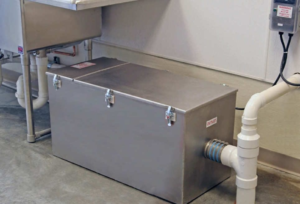Grease Trap Perth (or interceptor) filters residual fats, oils and grease (FOG) from wastewater before it enters the city sewer system. They must be pumped regularly to prevent buildup and clogs.
FOG blockages in sewer pipes can cause costly sanitary sewer overflows. That’s why many municipalities require the installation and maintenance of grease traps at commercial kitchens.

Every restaurant serving greasy food should install a grease trap. This is because grease clogs drains and slows down the flow of wastewater, which leads to pipe damage. To avoid these issues, you need to limit the amount of grease dumped down your drains by scraping extra food off plates before throwing them away or recycling used cooking oil into a sustainable biofuel.
If you have a restaurant grease trap, you should clean it regularly to reduce the risk of blockages. Professionals understand how the grease cools and solidifies inside the traps and know where to look for blockages so they can fix them quickly. Regular service will also help you stay compliant with local city laws regarding waste disposal, which could save you hefty fines in the future.
Another reason why you need to have a commercial grease trap is that it protects the environment. Fats, oils and grease (FOG) can damage the pipes and sewage system in your restaurant as well as the surrounding environment. When untreated FOG seeps into water catchment areas, it can cause massive environmental problems that take years to fix. Commercial grease traps prevent FOG from flowing into waterways, which helps protect the health and safety of people who drink the water.
Failing to have a commercial grease trap in your restaurant can result in expensive repairs and even business closures. Regulatory agencies do not take kindly to restaurants that allow their grease to flow into public sewer systems. This causes blockages that disrupt city water services and leads to costly cleanups.
In addition, the food waste left behind in a dirty trap can produce sulfuric acid, which damages the trap itself. A clean, properly functioning trap will last longer and will require less maintenance than a clogged, smelly trap. Aside from protecting your plumbing, a properly maintained grease trap can reduce the risk of a fire in your restaurant. In addition, it can also lower your insurance premiums. These benefits make the cost of maintaining a grease trap well worth it. To keep your grease trap clean and operating at its best, it should be cleaned regularly by a licensed, insured, reputable company like Helgerson’s Environmental.
Grease Trap Installation
Grease traps are a necessary component of many restaurants’ plumbing systems. They help to reduce the amount of fats, oils, and grease (FOG) that can cause blockages in pipes and sewer lines. They also help to prevent wastewater from backing up into food service establishments, which can lead to fines and downtime while the plumbing is repaired.
Almost all restaurants are required by law to have grease interceptors or solid waste interceptors installed. In addition, many hotels, schools, factories, bars, and coffee shops are also required to have one or more. These devices are designed to hold used cooking oil until it can be collected for recycling or disposal by a licensed waste management company like DAR PRO Solutions.
Restaurants should be careful to properly install their grease traps. The location and size of the trap must be carefully chosen to ensure proper operation. In some cases, the grease trap must be installed outside of the kitchen area to avoid exposing staff members to contaminants. It is also important that the inlet and outlet pipes are properly connected to the sink drains.
To ensure that your grease trap is working correctly, it must be pumped on a regular basis. Typically, this is done by a licensed and experienced commercial plumber.
When you need your grease trap pumped, it is important that you schedule the appointment as soon as possible to minimize downtime. During the pumping process, a professional will inspect the unit to make sure that it is functioning properly and in compliance with local regulations.
If your grease trap is not regularly emptied, it can quickly become clogged with FOG, which will cause wastewater to back up into the kitchen. Clogged traps will also smell and can result in serious health and safety issues. This is why it is essential that restaurants and other food facilities hire a licensed plumber to handle the installation, maintenance, and cleaning of their grease traps. By doing so, they can focus on their real priorities and avoid the costly consequences of a clogged grease trap.
Grease Trap Maintenance
The grease trap is a vital component in keeping FOGs (fats, oils and greases) out of the sewer system, where they can clog pipes and cause overflows and backups. Local regulations require restaurants to have these grease control devices installed and maintained to prevent this problem. To ensure these devices function properly, they must be inspected regularly and cleaned to remove accumulated grease. To avoid environmental consequences, lengthy cleaning processes and added costs, establish a regular grease trap service schedule with a professional.
Depending on kitchen usage and the size of the trap, draining or pumping should be performed every 2-4 weeks to prevent excessive FOG build-up. During this process, the technician will thoroughly clean and scrub the trap and its components, including baffles, air relief valves, piping and the exterior. He will also inspect for any damage or issues and perform the necessary repairs. He will then evacuate the wastewater and grease contents to be disposed of in compliance with local FOG regulations.
If the plumbing downstream of your grease trap becomes clogged with FOG, it may be necessary to use line jetting. In this process, a highly pressurized hose is sent down the line to blast away clogs and wash them downstream into the municipal sewer system.
FOG trapped in the grease interceptor can emit unpleasant odors, contribute to sewer blockages and slow sink drainage. Fortunately, preventing these problems is relatively easy with the right grease trap maintenance practices.
Do’s and Don’ts of Grease Trap Maintenance
While it may be tempting to use bleach, emulsifiers, enzymes or other chemical cleaners in your grease trap, they can actually do more harm than good. These chemicals kill the natural bacteria that dine on the FOGs in the trap, causing them to flow down the drain into the sewer system where they can clog pipes and cause sewer backups.
Another way to help reduce odors, slow sink drainage and clogged pipes is to add a biological grease treatment fluid into the trap at the inlet stage. This solution combines non-pathogenic bacteria with nutrients and enzymes to break down FOG and aid in grease trap performance.
Grease Trap Chemical Treatment
When a restaurant or commercial kitchen doesn’t maintain its grease traps properly, it can lead to a host of calamities. These include foul odors, blockages, and overflows that can destroy a business’s reputation and brand image. Luckily, you can avoid these calamities by following these tips to keep your grease traps in good working condition:
One of the best ways to prevent a grease trap from overflowing is by chemically treating it regularly. Chemicals, such as CGTC 7150, help break down and emulsify grease, allowing it to be more easily removed from the trap. This product can be added to the grease trap or sump pit on a regular basis, either before or after pumping or any other maintenance routines.
While many restaurants and commercial kitchens rely on heavy-duty degreasers to clean their grease traps, these products can actually harm the bacterial population that lives inside a grease trap. Additionally, these chemicals and degreasers often only dissolve the grease enough to leave the trap. As soon as the grease enters the wastewater system, it re-congeals and hardens, creating costly and damaging clogs.
When it comes to grease trap chemical treatment, there are two options: a microbial product or an enzyme dosing system. A microbial product is a biological solution that contains bacteria, which feast on FOG and convert it into water and carbon dioxide. These products can be dispensed into the grease trap on a consistent basis, allowing a healthy colony of bacteria to digest FOGs in the trap.
An enzyme dosing system uses enzymes, which are protein molecules that accelerate chemical reactions. These systems can also be dispensed into the trap on a consistent basis, allowing the enzymes to break down and emulsify FOG in the trap. This significantly reduces the amount of grease that is in the trap and the frequency of manual cleanings.
Aside from adding chemical treatments to the trap, it’s also important that staff members practice proper waste disposal. This includes disposing of food scraps in the trash instead of in the kitchen drains, and keeping sinks and drain lines clear of any obstructions. Educating staff on these best practices can prevent the build-up of FOGs in the kitchen and ensure that the grease trap is always functioning properly.

